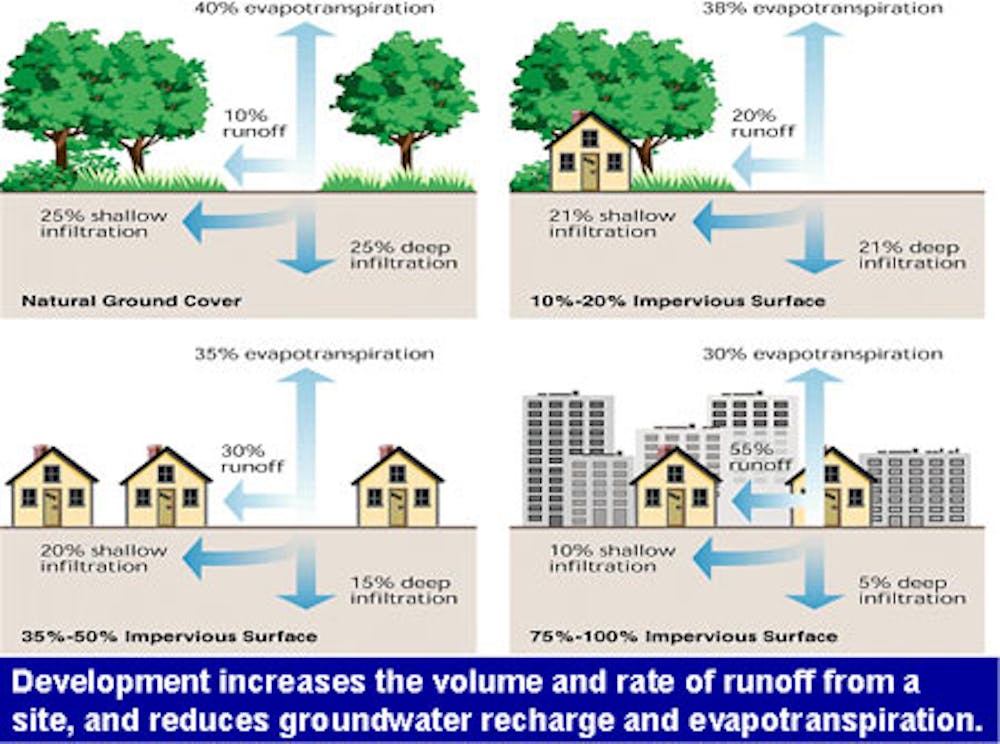How Does Stormwater Runoff Affect The Environment
When stormwater is absorbed into soil it is filtered and ultimately replenishes aquifers or flows into streams and rivers. Stormwater runoff can also close swimming beaches and contaminate drinking water supplies.

Stormwater Innovations Mean Cities Don T Just Flush Rainwater Down The Drain
Environmental flow assessment frameworks have begun to consider changes to flow regimes resulting from land-use change.

How does stormwater runoff affect the environment. These sensors are thin and like hairs and the stormwater runoff can damage those sensors. As development throughout the world booms so does the potential for a variety of environmental problems and challenges. Climate changes including more frequent and intense storms and more extreme flooding events can increase stormwater runoff.
Stormwater pollution has contributed to closing thousands of acres of productive shellfish growing beaches. Fish and aquatic life can be negatively impacted by surfactants such as oils detergents and soaps. An increase in stormwater runoff can exacerbate existing or introduce new pollution problems.
However runoff from developed systems usually has a drastically different effect on its surroundings see table below. Polluted stormwater runoff can be harmful to plants animals and people. Both surface and groundwater are susceptible to contamination from stormwater runoff both of which are sources of drinking water.
In natural systems it helps maintain rivers and the wildlife that thrive on them including humans. Uncontrolled stormwater runoff has many cumulative impacts on humans and the environment including. The Washington Department of Ecology estimates that one-third of all the polluted waters in the state are polluted by stormwater runoff.
Land use changes usually those directed toward urbanization have the potential to increase runoff from any given site. Rainwater travels to low-lying bodies of water including oceans lakes rivers streams and aquifers. How Does Stormwater Runoff Occur.
As the percentage of impervious unvegetated surface increases so does the total runoff volume and the peak rate of flow. One such challenge facing engineers developers and regulators is how to deal with the increase in stormwater runoff on construction sites. Stormwater run-off happens during every storm event.
For more information on the water quantity design and performance standard see Chapter 5. As more impervious surfaces are built the volume of stormwater runoff being contributed to the natural waterways also increases. Flooding - Damage to public and private property Eroded Streambanks - Sediment clogs waterways fills lakes reservoirs kills fish and aquatic animals Widened Stream Channels - Loss of valuable property.
Stormwater runoff that is attributable to the portion of the site on which the proposed development or project is to be constructed. As these materials are picked up by stormwater runoff and carried through storm drains they are deposited into lakes oceans rivers and other bodies of water. Heavy rain storms create a rapid influx of water which can cause a host of health and environmental issues.
Computing Stormwater Runoff Rates and Volumes. Once runoff soaks into soils plants and microbes can naturally filter and breakdown many common pollutants found in stormwater. Water Quality Improvements When stormwater runoff is reduced less water is available to transport pollutants in its path to nearby surface waters.
On the contrary urban stormwater contains chemicals from fertilizers that can run off into receiving waters and cause some serious damage to the environment especially if that environment just so happens to be a city or town. Today stormwater is not the boon for the environment that it used to be. Additionally stormwater runoff can cause floods or even water shortages.
This contaminated runoff can also have serious repercussions on human health. Mitigating stormwater has become a prime directive of cities and states as they look to reduce the impact on. When salmon cannot find what they need to live spawn eat and avoid danger their chances of surviving are drastically reduced.
Water that would otherwise have percolated into the ground and eventually reached the water table is instead directed to rivers lakes. A new study shows that stormwater runoff can have a dramatic negative impact on the health of coho salmon due to the contaminants that are often washed into the water from land sources. Runoff can carry a lot of sediment When storms hit and streamflows increase the sediment moved into the river by runoff can end up being seen from hundreds of miles up by satellites.
How Does Stormwater Affect Drinking Water. Urban stormwater runoff which degrades streams through altered volume pattern and quality of flow presents a problem that challenges dominant approaches to stormwater and water resource management and to environmental flow assessment. Nadia Sabeh in Plant Factory Second Edition 2020.
Stormwater runoff poses many challenges to cities including flooded streets strain on sewage conveyance systems and waste water treatment plants and groundwater pollution of nearby water bodies. Toxic or Harmful Chemicals. Simply put stormwater leads to excess pollution in the environment.
How Stormwater Affects Your Rivers American Rivers

Trees For Stormwater Management Home Garden Information Center

Stormwater Issues Impacts Environmental Natural Resource Issues
